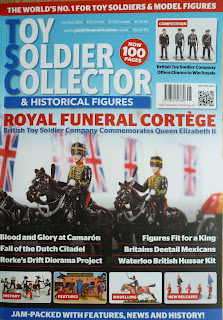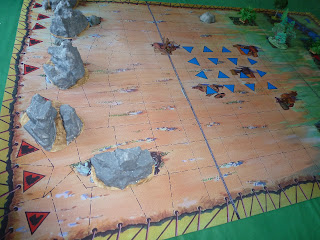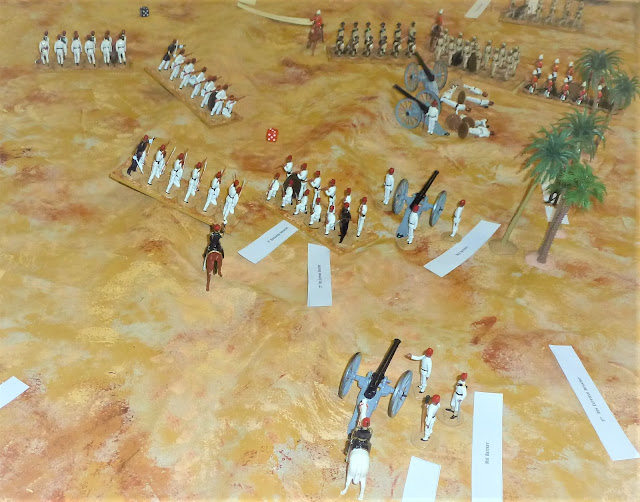This past year I embarked upon a review of how I store and display the unruly mass of toy soldiers accumulated in a largely haphazard way over the past six plus decades.
When I have a little money, I buy Toy Soldiers; and if I have any left, I buy food and clothes. (with apologies to:) ERASMUS
Wednesday, 7 May 2025
Britains American War of Independance Swoppets.
Tuesday, 30 July 2024
John Ruddle's Battleship
On 6th December last year the Toy Solder Collection of the late John Ruddle was sold by C&T Auctions and I am told that the sale raised £100,000. Here is a link to the online catalogue, compiled by James Opie, which in itself is a valuable resource for collectors of old toy soldiers: The Toy Soldier Collection of the Late John Ruddle Auction (candtauctions.co.uk)
But not everything went to auction; the wargame buildings, accessories, homecast figures and ships from his garden were considered unsuitable for inclusion in the sale, largely due to their condition, and were sold privately as a job lot. After cleaning up and some repair most of the ships were sold through a collectors shop in Gosport, a Naval town just outside Portsmouth, where they were mostly snapped up by retired Naval officers as garden ornaments.
John had told me, some years previously, that he'd sold all of his model ships to a collector in Germany and I assumed he meant his garden battleships, naturally I was disappointed that I'd never see them again. I realise now that he meant his collection of 1:1200 scale waterline ships, for which there is a much larger following in Germany, that made a lot more sense to me. The last two garden battleships found their way to the London Toy Soldier Show last year so I couldn't pass up the opportunity to acquire one as a piece of iconic wargaming history.
Thursday, 5 October 2023
John Ruddle 1932 - 2023
I don't normally buy Toy Soldier Collector magazine, because it mostly seems to be about reviewing new product, but flicking through the latest issue I noticed two articles of interest.
Which leads me neatly on to the second article of interest and this is two pages written by Paul Holcroft Wright about the new edition of Funny Little Wars, a reworking of the original layout with all new illustrations and incorporating a lot more background to H.G. Wells. I know that several other bloggers who visit here are fellow members of the FLW group and will already have the new edition but I couldn't pass up the opportunity to give it a mention.
Sunday, 26 March 2023
Battle Cry Vitoria 2
Here are the rest of the pictures I took of last year's game of Vitoria, which Anthony played using the Battle Cry rules system.
Friday, 24 March 2023
Battle Cry Vitoria
About this time last year Anthony and I played this game, based on the Battle of Vitoria in 1813, using the Battle Cry rules system. With the passage of time I can't remember the details too well, suffice it to say that I commanded the French and took a good trouncing, so at least we managed to keep the correct historical perspective! I did however take lots of pictures, so here over two post are lots of toy soldiers with few words to interrupt them.
Thursday, 28 April 2022
More of the new display
I've been wondering which figures to display on the extra shelves I added to my IKEA display cabinet, this is what I've come up with so far:
Friday, 7 January 2022
Unknown Hussar conversion from Britains hollowcast toy soldier.
This is a conversion of an old Britains hollowcast toy Hussar into.... well another Hussar, but who or which Regiment does he represent?
Saturday, 26 June 2021
Battle of the Little Big Horn
Anyone who was a schoolboy in the 1960's will remember the Waddingtons board game of the Battle of the Little Big Horn, it came with some rather nice 40mm figures of General Custer, his 7th Cavalry and the opposing Sioux and Cheyenne Indians. Well sometime last year Anthony had the original board copied onto a 6'x4' mat for use with 54mm toy soldiers but the ensuing pandemic has prevented us playing it, until today, which by the purest of coincidence happens to be the 145th anniversary of the actual battle.
Sunday, 6 June 2021
Italian Wars Imperial Cavalry
Or at least my interpretation of them, I'm not sure they'd score many marks for accuracy but then they are just toys for playing 54mm wargames. Mostly converted from Britains Deetail knights, except for the rearing figure in the middle which started life as a chess piece from a Harry Potter partwork! The shield designs tie them all together as being part of the same unit, maybe one day I'll get around to doing the French opposition?
You'd think that one set of figures, which are mostly all silver would take no time at all to paint? Not so, these have taken an eon, not that they're difficult but just down to a lack of enthusiasm, it's been a lost year, many, many projects started, hardly any finished.
In the absence of any games to report I may just start posting up random pictures of toy soldiers, these chaps have already featured on Facebook so apologies if you're fed up with seeing them!
Monday, 26 October 2020
A Crimean One Hour Wargame.
A few weeks ago we decided to hold an impromptu socially distanced game before the Powers that Be extended the lockdown to prohibit meetings of more than one household again. These are strange times. The 2 metre wide table and a few other simple measures ensured that proper social distancing was observed, it's not difficult when there's a will and common sense prevails.
Scenario One, Pitched Battle, was selected from OHW and toys suitable to the Crimean War were quickly garnered together. The scenario called for a minimal terrain, the British drew units of infantry, skirmishers and cavalry while the Russians were favoured with infantry, cavalry and artillery! Here's how it went:
Wednesday, 22 July 2020
Early Toy Soldier Newsreels
Now this is a bit of archive footage I haven't seen before, it's an early meeting of the British Model Soldier Society. Among the luminaries I spotted Otto Gottstein (in the opening shot, sitting at the far end of the table smoking a cigarette, next to a chap with a pipe) he was President of the Society at the time and a great patron of the hobby. Also I think I see a young Deryck Guyler (at about 22 seconds in) who was a keen member of the BMSS before going on to be one of the founding members of the Society of Ancients. The clip includes a rather nice selection of model knights produced by Richard Courtenay.
Model Soldiers 1953
I have Detlef Heerbrand to thank for finding this clip and posting it on facebook (which I finally got around to joining this month - a sure sign that it's days are numbered). It features Bill Carman who was Vice Chaiman of the BMSS at the time and was one of the first to manufacture model soldiers for the collector. His figures are a bit basic by modern standards but I've always been a big fan of them so I was particularly pleased when this surfaced.
Archive footage shot inside the Britains factory showing the hand casting of hollowcast figures, through to cleaning the castings, painting and packing them.
This piece of footage has been doing the rounds for a while but given that it's dated 1965 it's interesting that the commentary points out the hollow cast figures shown are made strictly for adults as collectors items. Britains ceased hollow casting in 1966, the story that this was because of lead paint and child safety fears is an urban myth, the truth is they just weren't selling enough. The second half of the film shows an injection moulding machine being loaded up with plastic pellets and states that production of plastics was in full swing for the juvenile toy market.
Model Soldier sale 1968
This newsreel covered the very first specialist auction of Toy Soldiers (in fact the first specialist auction of any toys), held by Knight, Frank and Rutley who were founded in 1896 as Valuers, Surveyors and Auctioneers, they are a well known Estate Agents (Realtors). I didn't recognise any of the faces amongst the crowd here but the toy soldiers needed no introduction.
Friday, 10 July 2020
Toy Soldiers of the Great War
Wednesday, 1 April 2020
Queen Mary had some Toy Soldiers.
William Britains, being the leading toy soldier manufacturer of the day provided a miniature example of a box of their toy soldiers for the dolls' house nursery, and they made a second set for the daughter of Frederick Britain, this is what it looks like:



















































